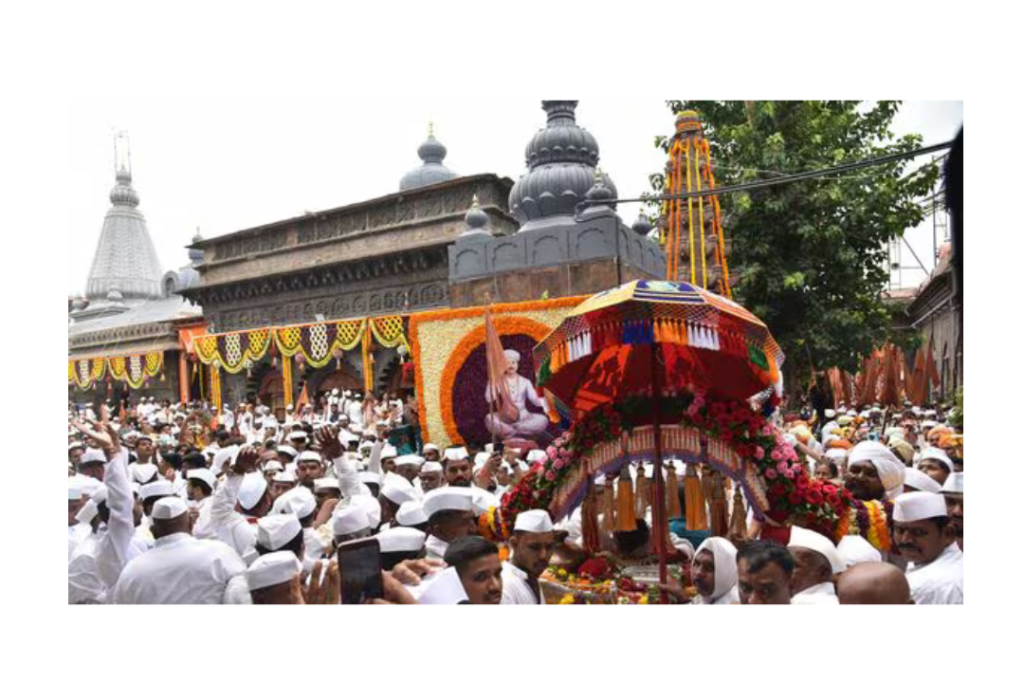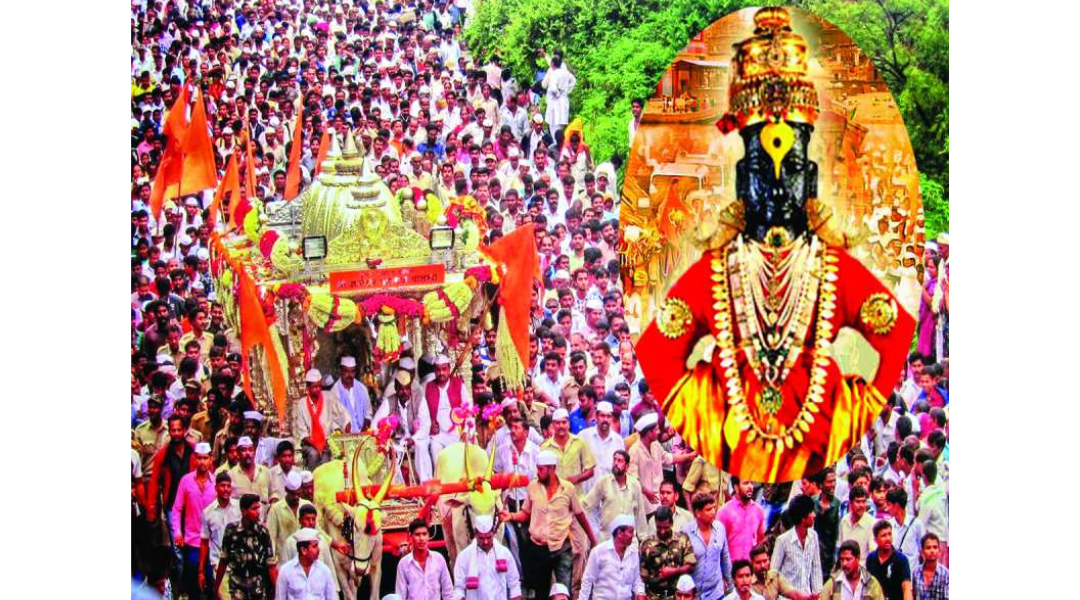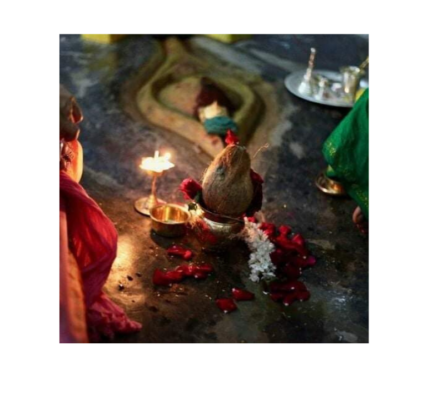The Pandharpur Wari is a lengthy 21-day pilgrimage that leads followers to Pandharpur, the hallowed home of Lord Vitthal, from different parts of Maharashtra. Millions of devoted pilgrims travel here every year on Ashadhi Ekadashi and Guru Purnima, when this age-old custom reaches its pinnacle. It is a historical and spiritual tapestry with roots in an 800-year-old past.
Table of Contents

The Sensory Panorama of Pandharpur Wari Devshayani Ashadi Ekadashi
The sensory overload of Pandharpur Wari Devshayani Ashadi Ekadashi might be overwhelming for first-timers. Countless saffron banners dancing in the breeze provide a sight to behold as one approaches and joins the pilgrimage procession. Men playing mridangams, veenas, and other musical instruments while wearing brightly colored turbans and clean Gandhi hats. With water containers or tulsi plants balanced atop their heads, women adorn the procession. The pilgrims’ lovely, deep hymns blend harmoniously with the sound of honking trucks. Initially, all that can be done is watch in amazement as the procession moves like an uncontrollably powerful stream.
The Varkari Sect and Its Profound Significance
Pandharpur Wari Devshayani Ashadi Ekadashi, The main rite of the Varkari sect, a Vaishnavite religious lineage from Maharashtra, is the Wari pilgrimage. At the centre of this tradition is Pandharpur, revered as the home of Lord Vitthal. Even though the Wari takes place four times a year in the Hindu months of Magh, Ashadh, Kartik, and Chaitra, the Ashadhi pilgrimage has grown to be the largest and most famous.
The Genesis of the Ashadhi Wari
Traditionally, the Ashadhi Wari begins at the samadhis (memorial shrines) of several Varkari saint-poets and ends at the temple town of Pandharpur on the auspicious Ashadhi Ekadashi. This pilgrimage, which lasts for about three weeks and is usually done on foot, allows Varkaris to commemorate their saint-poets and renew their commitment. ‘Varkari’ means ‘those who perform the Wari,’ and refers to all devotees who make the journey, regardless of their official status within the sect.
The COVID Crisis and Its Ramifications
This year, the COVID-19 pandemic has disrupted the long-standing custom. Rather than the customary large processions, the palanquins (palkhis) of several saint-poets would go to Pandharpur in a specially-appointed car with a small number of attendants. That being said, this disruption is not unprecedented. Records from the past show that the Wari was restricted in the past, most notably in 1944–1945, maybe as a result of World War II.

Eminent Processions within the Wari
The Wari pilgrimage usually consists of several big and small processions honoring particular saint-poets. The oldest, largest, and most well-known processions are dedicated to Dnyaneshwar and Tukaram. Tradition of Pandharpur Wari Devshayani Ashadi Ekadashi, The group was founded by the 13th-century saint Dnyaneshwar, who wrote the Dnyaneshwari, a Marathi commentary on the Bhagavad Gita. The 17th-century saint Tukaram wrote several abhangs (devotional hymns) for Vitthal and was a strong proponent of kirtans and bhajans being used in devotional practices.
Innovations by Haibatrao Baba Arphalkar
Pandharpur Wari Devshayani Ashadi Ekadashi, Important modifications were brought to the Wari in the early 19th century by Haibatrao Baba Arphalkar, a wealthy aristocrat from Satara area. As a former soldier, he planned the journey with military precision, complete with a set itinerary and regal decorations. The custom of putting the sandals in a beautifully adorned palanquin that is pulled by a chariot was also started by him.
The Antiquity of Pandharpur Wari
The Varkari pilgrimage to Pandharpur has several different origin stories, but it is generally accepted to be at least seven or eight centuries old. On the other hand, the processions honoring saint-poets are more modern; Pandharpur Wari Devshayani Ashadi Ekadashi, Haibatrao Baba’s innovations are credited with giving the Wari its current form.
Rituals Along the Wari Route
Along the Wari road, a number of rituals are carried out, including the well-known Ringan, which is a race between two horses, one of which is unmounted. The horse without a rider wins the race traditionally, representing the saint who is riding it. Pandharpur Wari Devshayani Ashadi Ekadashi, Over the years, more palanquins have joined the Wari, in addition to those of Dnyaneshwar and Tukaram. The number of pilgrims attending each procession rises with time, from a few hundred to several lakhs.
The Deity Vitthal
Pandharpur Wari Devshayani Ashadi Ekadashi, The Varkaris look forward to seeing Vitthal, their patron deity, at the end of their difficult journey. The black idol of the goddess, standing with arms akimbo on a high platform that resembles a brick, is housed in the Vitthal-Rukmini temple in Pandharpur. It is thought that Vitthal, a manifestation of Vishnu-Krishna, was introduced to Pandharpur by the wise Pundalik. Pundalik stood before Vitthal, who was moved by his parents’ devotion. But Pundalik, lost in his parental responsibilities, instructed Vitthal to wait while standing on a brick, or “vit” in Marathi, giving the god his own moniker and posture.
Also, Read : The Profound Essence of Nirjala Ekadashi Fasting in Hinduism
Tukaram’s Playful Rebuke
Funny enough, Tukaram asks, “Hey Pundeya! ” in response to Pundalik’s bold move of forcing Vitthal to stand on a brick. You made Vitthal stand there, so why are you so pleased of it? Is there a reason you lack fear? The way you were hurling a brick at him?” the importance for Pandharpur Wari Devshayani Ashadi Ekadashi.
The Festivity of Sohla
‘Sohla,’ a Marathi word that is frequently connected to the Wari, denotes a festivity or celebration. The Wari is celebrated as a major festival rather than a pilgrimage or yatra, with palanquins, chariots, veenas, and tulsi plants carried by the Varkaris, along with floral- and decoration-adorned representations of Vitthal and Rukmini. Pandharpur Wari Devshayani Ashadi Ekadashi, Palanquin stops along the route to Pandharpur are festooned with lavish decorations, and celebrations are frequently arranged, attracting the attention of the local populace.
The Modest Life of Varkaris
Pandharpur Wari Devshayani Ashadi Ekadashi, Since the majority of Varkaris are from rural, agricultural backgrounds, they dress simply and modestly. When dharamshalas (religious rest homes) are full, many rely on sponsors for food and sleep outside. Those with means go in groups. Rain or lack of anything can sap the Varkaris’ fervor as they whirl wildly while holding hands with other pilgrims while dancing to the beat of the mridangam.

A Verse for Pandurang
Here is a verse dedicated to Pandurang
“Dev bhulla bhavasi
Saandoniyaan Vaikunthasi ॥1॥
Ughda aala Pandharapura
To paratpar Soira ॥2॥
Pahuniya Pundalika
Bhulla tayacha kautuka ॥3॥
Ubha rahila vitevari
Eka Janardani Hari”
Hey Pundya! Why are you so proud
As to make Vitthal stand there?
Why are you so bold
As to toss a brick to him?
Conclusion
The Pandharpur Wari is a lively celebration of faith, community, and dedication that goes beyond a simple pilgrimage. Numerous followers have traveled this path for centuries in order to honor their saint-poets and to reaffirm their faith. Pandharpur Wari Devshayani Ashadi Ekadashi, The essence of the Wari has not changed in spite of changing obstacles and changes; this is evidence of the Varkari tradition’s enduring spirit and unshakable commitment to Lord Vitthal.
Also, Read: The Sacred Shaligram Stone: Significance, Rituals, and Benefits





